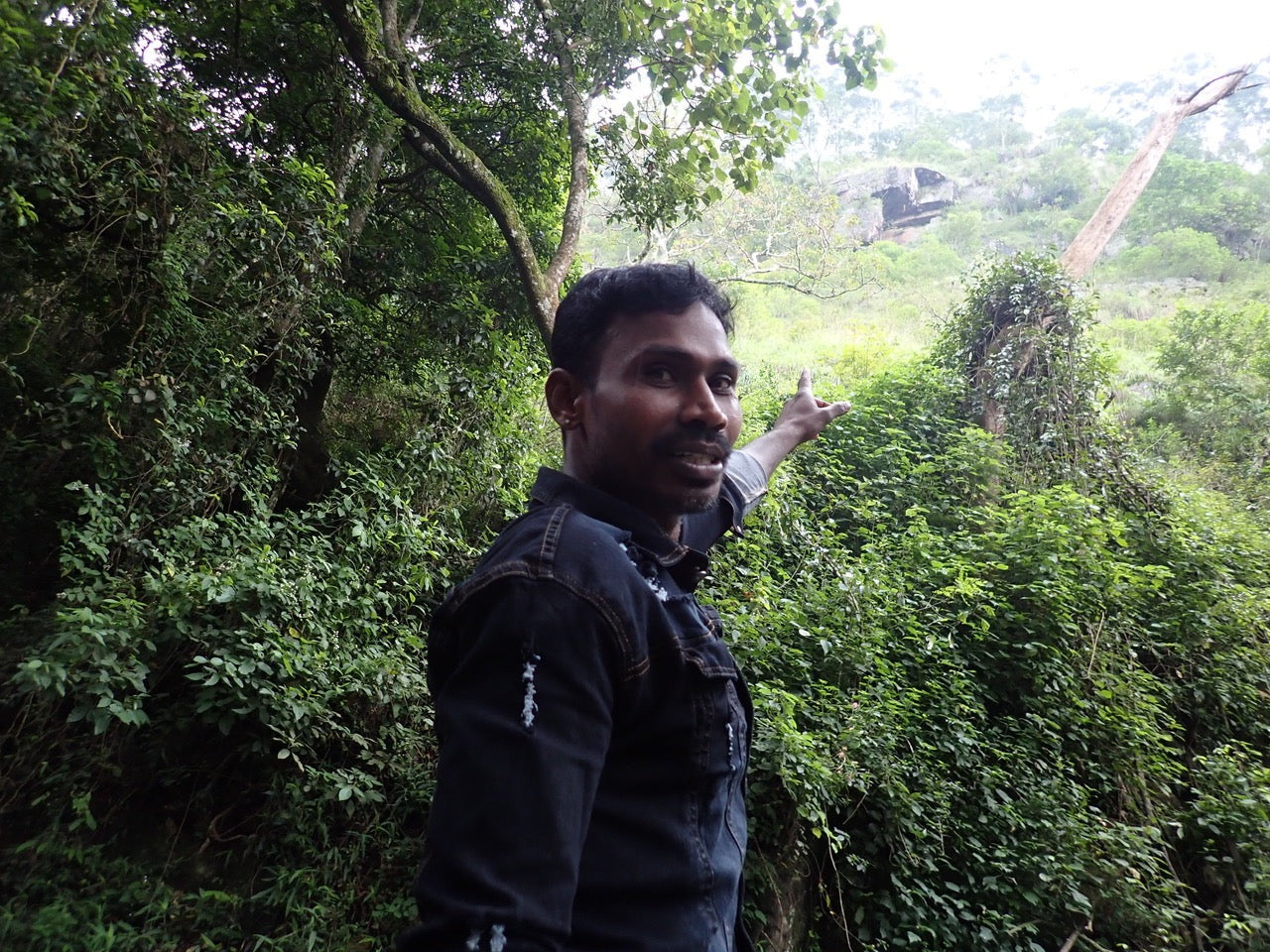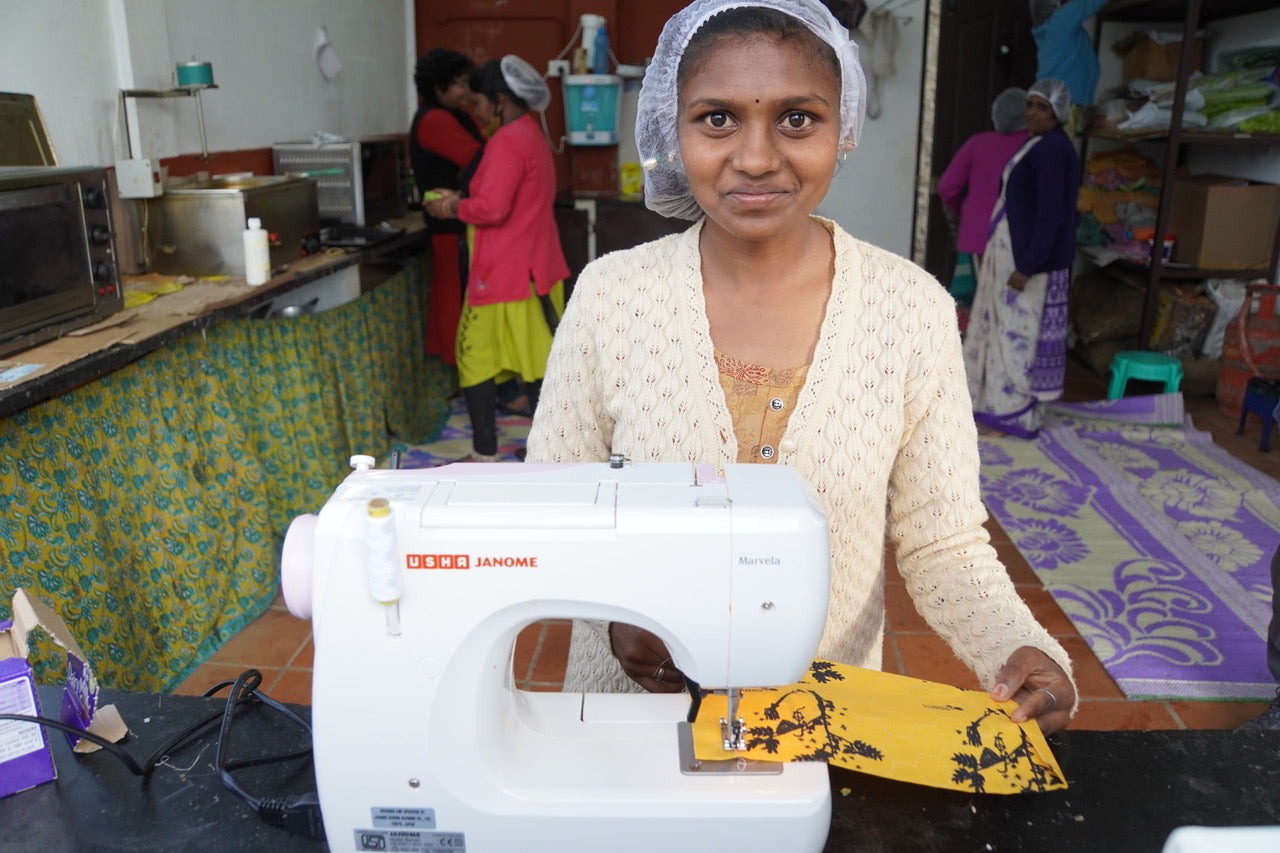About Fairly Traded Wax

We use beeswax from the Asian honeybee, Apis dorsata (or ‘Rock Bee’). The bees are much bigger than European honeybees and they live in the wild, in forests and jungles. Their honeycombs can measure up to 1.5 m. The bees attach them to rocks or the branches of tall trees.
Tribal communities in India still have strong links to the forests. Climbing rocks and trees to collect honey and honeycomb can be extremely dangerous. But this time-honoured tradition also helps to protect the forests. It is a sustainable method that provides income to one of the most disadvantaged groups of people.
How we collect our wax
The Western Ghats, a coastal mountain range in India, are one of the world's biodiversity hot spots. Situated in the most eastern part at an elevation of 2000m is the town of Kodaikanal. Visitors taking the winding road into the mountains will enjoy the occasional look back over the plains shimmering in the heat, marvel at the tall trees that mark the jungle's edge and enjoy the air getting cooler with every hairpin curve. But it takes trained eyes to spot the hornet-sized rock bees (A. dorsata) combs from a moving vehicle. Measure up to 1.5m across, the dorsata combs are big enough, but one must know where to look for the characteristic semi-circle shapes: high up in the crowns of trees or under steep rock inclines.
Tourists and other visits also rarely spot the villages of the Palani. These indigenous people have always lived in India's forests and are reluctant to give up the tradition to this day. In principle, the Adivasi, as India's indigenous people are known, have the right to live in the forest, forage and use forest products. In 2013, the forests around Kodaikanal were elevated to the status of 'Wildlife Sanctuary'; the rights of wild animals thus trump those of humans. The semi-nomadic Palani may continue to forage, but they no longer are allowed to live in the forests. Through a government resettlement programme, all families were forcibly moved into one of 60 newly built villages along the main road.
One of those villages is Moolayar. By now, Nishita Vasant, co-founder of Hoopoe on a Hill, knows precisely where she has to turn off from the main road onto a steep dirt track. After another sharp curve, we reach a clearing with a volleyball court and a village. A group of honey collectors is there to meet us, and their leader is Maari, a tall, lanky 39-year-old. "When we collect honey, we usually stay in the forest for several days and nights", says Maari while he takes us through the village to one of the small houses. We leave our shoes on the roofed veranda and enter the roughly two-by-three room where a family lives and sleeps, where meals are cooked, and the children do their homework. There is no running water; it has to be fetched at an outside tap serving two or three households, but the house is connected to the grid, and the family has a light at night.
Next to the main room is a small space where not just utensils and bedding are stored, but honey and wax, too. Honey is collected only twice a year: in May and after the monsoon in October. During the winter months, the bees migrate to a different region.
To find honey, the collectors walk deep into the forest. During the day, they scout out trees with large combs and discuss the easiest way to get to the branches they are attached. A. Dorsata bees are considerably bigger and more aggressive than European honey bees. Getting stung is very painful and causes considerable swelling. None of the men owns a bee suit; being stung is part of the job.
Wax collectors
Three to five men work in a group; the honey must be collected at night when the bees are less aggressive and don't pursue the collectors. Each team member has a dedicated job to do. 'Climbers' like Maari scale the tree to a height of 15 m or more. Protecting mouth, nose and ears with a scarf, they crouch on the branch to which the comb is attached. The men on the ground use a rope to pull up a bucket. He attaches a smoker to his leg to get as many bees as possible away from the comb, explains Maari; then, he leans over to cut out the comb's parts containing honey and places them in the bucket. The 'ground crew' replaces the full bucket with an empty one. Then the men manually squeezed the honey into the canisters they brought along. Each team harvests no more than 80kg (roughly the content of three big combs) because they will have to carry the canisters back to the village, a trip over rough terrain that can take several hours. They also take as much wax along as they can, it does not weigh much, but it is bulky and difficult to transport.
Maari was 12 when he accompanied his father on a honey gathering excursion for the first time. Today he is not only one of the most experienced climbers but also one of the most daring. Secured only by a single rope, he even harvests combs from underneath overhanging rock formations and records it on his mobile phone, watch the video here. He often dreams of bees. For Maari, these are the voices of his ancestors that let him know where he should go and which trees and rocks he should avoid. Like Maari, most Palani still feels a deep connection to their ancestors, their traditions and the forest.
Kadagathadi is another Adivasi village from which Nishita Vasant buys wax and honey from Hoopoe on a Hill. 33-year-old Muthu Pandi organises the collection. He planned to attend college and attend a boarding school some 40km away. But after class 10, he decided that living so far away from the forest was not for him. He returned to his village to become a honey gatherer. Today he not only organises the collection teams, but he also does the accounting and ensures everyone gets their fair share of the profit. The forest still plays an essential role in the villagers' lives: they collect lichen and yam growing in the wild; on small forest clearings, they grow coffee, bananas, avocado, oranges and beans. The authorities have informally agreed to such agricultural use of forest land, but the permission could be withdrawn at any time, says Palani.
Every other family in Kadagathadi takes part in the honey collection, and money from honey makes up a substantial part of their overall income. Therefore, Muthu Pandi discusses with Nishita Vasant whether an extra crew should join the collection teams and help retrieve more wax from the forest. Since the Hoopoe on a Hill women's cooperative produces wax wraps, the demand and the price for wax have increased. Being able to sell more wax could provide additional income, and for Hoopoe on a Hill, it would be good to know that sufficient wax would be available to fulfil the orders for more wax wraps that they hope European customers will place.
The story behind our wax wraps

As the name indicates, the two-story building in which the south Indian women's cooperative Hoopoe on a Hill produces their wax wraps is situated on a hill from which one has a splendid view across terrace vegetable fields, fruit orchards to the town of Kodaikanal on the other side of the valley.
Sheila is one of the eight Hoopoe women, oblivious to the scenic view. She does not lift her eyes from the workspace underneath the window as she carefully irons the pieces of cotton cloth her colleagues have cut to the required size. Rani and Nimi's job is to apply the wax. "We have done endless trials until we found the right mix", says Nishita Vasant, one of the two Hoopoe on Hill founders. Resin is one of the ingredients. It comes in blocks and has to be broken into pieces by hand. Even more important is, of course, the wax. It comes from an Indian honey bee species, the 'rock bee' (Apis dorsata), which is common in this most eastern part of the Western Ghats mountain range. The wax must be filtered several times, then mixed with the resin and slowly heated. It takes about half an hour and constant and repeated stirring until the mix has the consistency and colour of treacle. Rani places one of the freshly ironed cotton pieces on a baking tray, dips a broad brush into the wax mixture and applies it evenly in a thin layer. The cloth is dried for a few minutes in an oven, then Rani carefully lifts it off the tray with two metal clips, gently moves it back and forth to cool it somewhat and then attaches it to a washing line. The freshly waxed cloths stay for a fortnight until they are correctly 'cured'.
Shobna and Sivaka are not only responsible for cutting the cloth to size, but they also cast the edges with pinking shears. With a pulley system, the finished wax wraps are sent upstairs through an opening in the ceiling. Here they will be packed and readied for shipment.
Nishita Vasant and Priya Mani founded Hoopoe on a Hill in 2016. From their work with non-governmental organisations, they knew that the only way to help indigenous groups and women was to provide them with income. To find a job in Kodaikanal shouldn't be a problem. At an elevation of 2000m, the town has a pleasant climate. Between April and August, it gets incredibly hot in most regions of India and anyone who can retreat to the mountains. Hotels, restaurants, souvenir sellers and boat owners who rent out the row and pedal boats to tourists who want to explore the artificial lake in the town centre are always looking for staff. But to work in Kodaikanal, one has to live there or have the means to get there. None of the women who work for Hoopoe on a Hill today has a motorbike or even a car. And there is only one bus to Kodaikanal in the morning and returning in the evening. As a result, the women have no option but to take an ill-paid, seasonal agricultural job – to get lucky and work for Hoopoe.
"When will we get new orders?" is the women's first question as we sit together over cups of tea. "When there are enough customers who realise how beautiful, practical and good for the environment the Hoopoe on a Hill wax wraps are" is the answer the women probably didn't want to hear. The money the women have earned has made a difference in their lives and their families: Rani has paid back a loan her husband took out in her name but without her knowledge. Sheila's father is a fruit seller. Due to Covid, the business is not going well, but now she can support her parents financially. Nimi could finally buy a TV. Shivaka purchased a cow and earned additional money by selling the milk. And Shobna has opened a savings account: in today's India, a good education costs money, and she is planning: her son is eight at present, her daughter two. Once they are grown up, Shobna wants them to be able to choose any profession and go to university if that's what they want.
The conversation flows easily, and it is evident that the women work well together and have a lot of fun. They trust each other; even personal problems are discussed quite openly, and solutions are found with Nishita's and Priya's careful and sensitive comments. The women gain more than a regular income through their work at Hoopoe. They have become self-confident and more independent.
And they are proud to produce such good wax wraps. They say all of them love the Jungle Book design, and the thought that in a far-away country, kids go to school or kindergarten every day, carrying their lunch in one of the Hoopoe wax wraps makes them happy.



